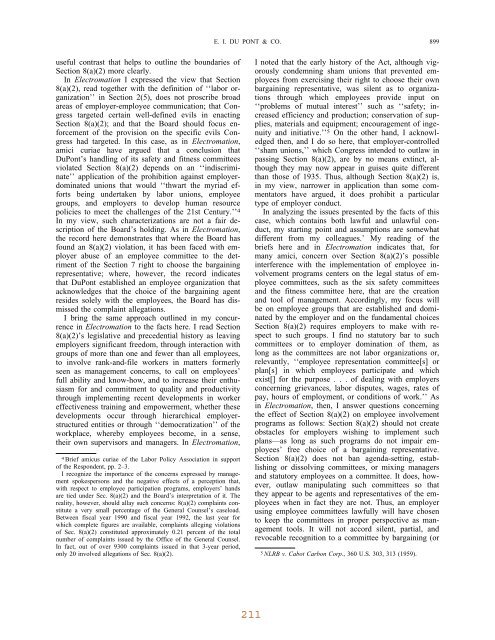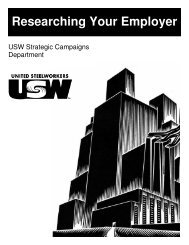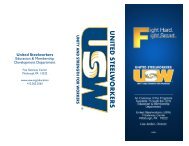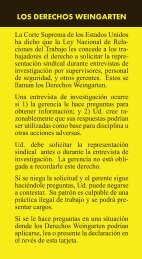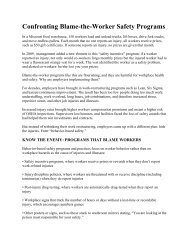Union Approach to Health and Safety: - United Steelworkers
Union Approach to Health and Safety: - United Steelworkers
Union Approach to Health and Safety: - United Steelworkers
Create successful ePaper yourself
Turn your PDF publications into a flip-book with our unique Google optimized e-Paper software.
E. I. DU PONT & CO.<br />
899<br />
useful contrast that helps <strong>to</strong> outline the boundaries of<br />
Section 8(a)(2) more clearly.<br />
In Electromation I expressed the view that Section<br />
8(a)(2), read <strong>to</strong>gether with the definition of ‘‘labor organization’’<br />
in Section 2(5), does not proscribe broad<br />
areas of employer-employee communication; that Congress<br />
targeted certain well-defined evils in enacting<br />
Section 8(a)(2); <strong>and</strong> that the Board should focus enforcement<br />
of the provision on the specific evils Congress<br />
had targeted. In this case, as in Electromation,<br />
amici curiae have argued that a conclusion that<br />
DuPont’s h<strong>and</strong>ling of its safety <strong>and</strong> fitness committees<br />
violated Section 8(a)(2) depends on an ‘‘indiscriminate’’<br />
application of the prohibition against employerdominated<br />
unions that would ‘‘thwart the myriad efforts<br />
being undertaken by labor unions, employee<br />
groups, <strong>and</strong> employers <strong>to</strong> develop human resource<br />
policies <strong>to</strong> meet the challenges of the 21st Century.’’ 4<br />
In my view, such characterizations are not a fair description<br />
of the Board’s holding. As in Electromation,<br />
the record here demonstrates that where the Board has<br />
found an 8(a)(2) violation, it has been faced with employer<br />
abuse of an employee committee <strong>to</strong> the detriment<br />
of the Section 7 right <strong>to</strong> choose the bargaining<br />
representative; where, however, the record indicates<br />
that DuPont established an employee organization that<br />
acknowledges that the choice of the bargaining agent<br />
resides solely with the employees, the Board has dismissed<br />
the complaint allegations.<br />
I bring the same approach outlined in my concurrence<br />
in Electromation <strong>to</strong> the facts here. I read Section<br />
8(a)(2)’s legislative <strong>and</strong> precedential his<strong>to</strong>ry as leaving<br />
employers significant freedom, through interaction with<br />
groups of more than one <strong>and</strong> fewer than all employees,<br />
<strong>to</strong> involve rank-<strong>and</strong>-file workers in matters formerly<br />
seen as management concerns, <strong>to</strong> call on employees’<br />
full ability <strong>and</strong> know-how, <strong>and</strong> <strong>to</strong> increase their enthusiasm<br />
for <strong>and</strong> commitment <strong>to</strong> quality <strong>and</strong> productivity<br />
through implementing recent developments in worker<br />
effectiveness training <strong>and</strong> empowerment, whether these<br />
developments occur through hierarchical employerstructured<br />
entities or through ‘‘democratization’’ of the<br />
workplace, whereby employees become, in a sense,<br />
their own supervisors <strong>and</strong> managers. In Electromation,<br />
I noted that the early his<strong>to</strong>ry of the Act, although vigorously<br />
condemning sham unions that prevented employees<br />
from exercising their right <strong>to</strong> choose their own<br />
bargaining representative, was silent as <strong>to</strong> organizations<br />
through which employees provide input on<br />
‘‘problems of mutual interest’’ such as ‘‘safety; increased<br />
efficiency <strong>and</strong> production; conservation of supplies,<br />
materials <strong>and</strong> equipment; encouragement of ingenuity<br />
<strong>and</strong> initiative.’’ 5 On the other h<strong>and</strong>, I acknowledged<br />
then, <strong>and</strong> I do so here, that employer-controlled<br />
‘‘sham unions,’’ which Congress intended <strong>to</strong> outlaw in<br />
passing Section 8(a)(2), are by no means extinct, although<br />
they may now appear in guises quite different<br />
than those of 1935. Thus, although Section 8(a)(2) is,<br />
in my view, narrower in application than some commenta<strong>to</strong>rs<br />
have argued, it does prohibit a particular<br />
type of employer conduct.<br />
In analyzing the issues presented by the facts of this<br />
case, which contains both lawful <strong>and</strong> unlawful conduct,<br />
my starting point <strong>and</strong> assumptions are somewhat<br />
different from my colleagues.’ My reading of the<br />
briefs here <strong>and</strong> in Electromation indicates that, for<br />
many amici, concern over Section 8(a)(2)’s possible<br />
interference with the implementation of employee involvement<br />
programs centers on the legal status of employee<br />
committees, such as the six safety committees<br />
<strong>and</strong> the fitness committee here, that are the creation<br />
<strong>and</strong> <strong>to</strong>ol of management. Accordingly, my focus will<br />
be on employee groups that are established <strong>and</strong> dominated<br />
by the employer <strong>and</strong> on the fundamental choices<br />
Section 8(a)(2) requires employers <strong>to</strong> make with respect<br />
<strong>to</strong> such groups. I find no statu<strong>to</strong>ry bar <strong>to</strong> such<br />
committees or <strong>to</strong> employer domination of them, as<br />
long as the committees are not labor organizations or,<br />
relevantly, ‘‘employee representation committee[s] or<br />
plan[s] in which employees participate <strong>and</strong> which<br />
exist[] for the purpose . . . of dealing with employers<br />
concerning grievances, labor disputes, wages, rates of<br />
pay, hours of employment, or conditions of work.’’ As<br />
in Electromation, then, I answer questions concerning<br />
the effect of Section 8(a)(2) on employee involvement<br />
programs as follows: Section 8(a)(2) should not create<br />
obstacles for employers wishing <strong>to</strong> implement such<br />
plans—as long as such programs do not impair employees’<br />
free choice of a bargaining representative.<br />
Section 8(a)(2) does not ban agenda-setting, establishing<br />
or dissolving committees, or mixing managers<br />
<strong>and</strong> statu<strong>to</strong>ry employees on a committee. It does, however,<br />
outlaw manipulating such committees so that<br />
they appear <strong>to</strong> be agents <strong>and</strong> representatives of the employees<br />
when in fact they are not. Thus, an employer<br />
using employee committees lawfully will have chosen<br />
<strong>to</strong> keep the committees in proper perspective as management<br />
<strong>to</strong>ols. It will not accord silent, partial, <strong>and</strong><br />
revocable recognition <strong>to</strong> a committee by bargaining (or<br />
4 Brief amicus curiae of the Labor Policy Association in support<br />
of the Respondent, pp. 2–3.<br />
I recognize the importance of the concerns expressed by management<br />
spokespersons <strong>and</strong> the negative effects of a perception that,<br />
with respect <strong>to</strong> employee participation programs, employers’ h<strong>and</strong>s<br />
are tied under Sec. 8(a)(2) <strong>and</strong> the Board’s interpretation of it. The<br />
reality, however, should allay such concerns: 8(a)(2) complaints constitute<br />
a very small percentage of the General Counsel’s caseload.<br />
Between fiscal year 1990 <strong>and</strong> fiscal year 1992, the last year for<br />
which complete figures are available, complaints alleging violations<br />
of Sec. 8(a)(2) constituted approximately 0.21 percent of the <strong>to</strong>tal<br />
number of complaints issued by the Office of the General Counsel.<br />
In fact, out of over 9300 complaints issued in that 3-year period,<br />
only 20 involved allegations of Sec. 8(a)(2). 5 NLRB v. Cabot Carbon Corp., 360 U.S. 303, 313 (1959).


